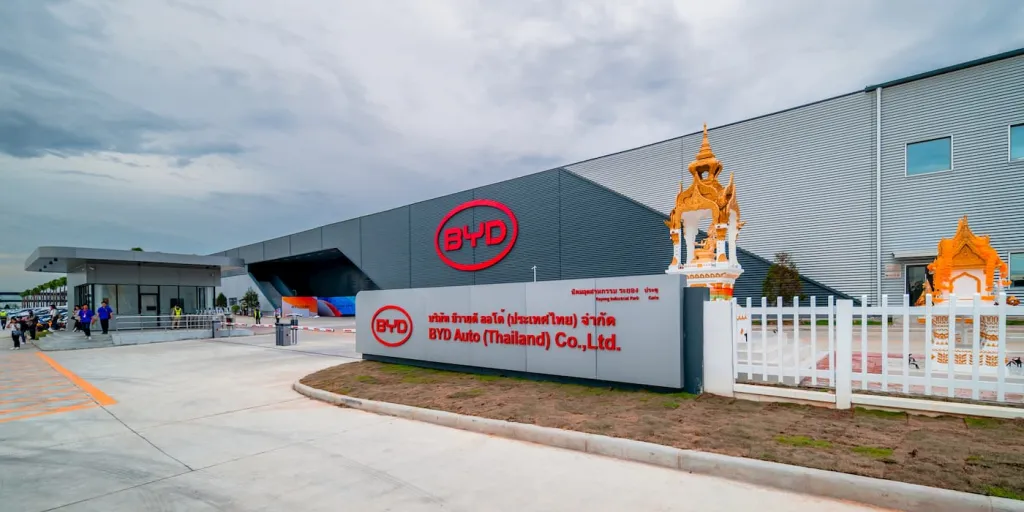It will require political vision, institutional reform, and sustained investment in human capital.
It will require political vision, institutional reform, and sustained investment in human capital.
By Mehmet Enes Beşer
For decades, Thailand has been Southeast Asia’s automotive powerhouse, earning the title of the “Detroit of Asia.” Thailand boasts a robust manufacturing base, world-class logistics centers, and stable policy backing, which have attracted investments from top carmakers and made it a regional export hub. But a nuanced shift may be in the works. Chinese electric vehicle giant BYD’s growing interest in Cambodia could signal the beginning of a new industrial era in the Kingdom—one where Cambodia is not just a satellite economy but also a major player in the region’s next-generation manufacturing game.
BYD’s entry into Cambodia holds more than what is happening in the world of economics today. It is a convergence of global trends and Cambodian aspirations. While the global economy is refocusing on electric mobility and reshaping global supply chains in response to geopolitical tensions and post-pandemic revival, Southeast Asia itself is becoming a battleground for industrial relocation and strategic investment. Cambodia, once dreamed of largely as a site for garment assembly and low-end assembly, is today being reimagined as a center of higher-end manufacturing, logistics, and even green technology.
BYD’s proposed investment is part of a broader strategy by Chinese companies to diversify their production bases outside China. Rising domestic labor costs, coupled with trade tensions and pressure for decoupling, are persuading firms to seek alternative locations elsewhere with cost advantages, preferential access to trade, and logistics’ proximity to emerging markets. Cambodia meets much of these criteria. The Kingdom enjoys duty-free entry into the primary markets under regional agreements like the Regional Comprehensive Economic Partnership (RCEP), a young and trainable workforce, and increased transportation connectivity with China and the nearby ASEAN economies.
Yet BYD’s entry would not just be cost arbitrage. It can be stimulus. The EV industry is an advanced ecosystem comprising battery supply chains, precision manufacturing, regulatory synchronization, and technical human resources. If BYD established assembly or component factories in Cambodia, it could generate powerful network effects—attracting ancillary suppliers, inducing vocational training programs, and causing government investment in infrastructure. What Thailand accomplished over decades could, in an age of digitally connected and climate-aware business, be condensed into years in Cambodia.
All that said, the attraction from Thailand must be handled with care and finesse. The state of Cambodia’s present industrial base, regulatory apparatus, and existing labor productivity remain too small-scale or rudimentary in nature, comparable to what exists across its western border. Thailand has a stable policy culture dating back, pro-automotive regulation, and mature and widespread supplier base, all several years in development. For Cambodia to replicate or even emulate that trend, it must be ready to undertake deep structural reforms—enhancing vocational training, enhancing transport and energy infrastructure, and building institutional capacity to lead industrial upgrading.
Above all, Cambodia also needs to learn from Thailand’s experience. Over-reliance on foreign-led manufacturing, without sufficient knowledge transfer or value capture at home, can limit long-term developmental dividends. The Cambodian authorities will need to negotiate investment agreements that include measures on local procurement, training, and collaborative research. SME-relation policies to incorporate into global value chains will also be essential. Managed effectively, BYD’s investment can not only serve as a cornerstone of industrial growth but also a driver of broader economic transformation.
Geopolitical forces are also at play. BYD’s venture into Cambodia is a demonstration of China’s ongoing efforts to consolidate its economic presence in Southeast Asia through mechanisms such as the Belt and Road Initiative and the Digital Silk Road. For Cambodia, this comes with both promise and danger. On the one hand, Chinese investment brings funds and technology. On the other, it increases over-dependency fears and political influence that such economic relationships could bring. Diversifying alliances—through the addition of Japanese, Korean, European, and American firms in addition to Chinese participants—will be key to achieving strategic balance and avoiding the pitfalls of unbalanced integration.
Social and environmental considerations have to be front and center as well. EV manufacturing is capital-based, and sloppy management can result in environmental decay or displacement of citizens. Cambodia needs to make sure that its transition towards high-value manufacturing is based on sustainable principles—adopting high environmental standards, promoting clean energy usage in the production process, and ensuring openness about land and labor practices. This green industrial future must be inclusive and responsible, and not just profitable.
Conclusion
The arrival of BYD in Cambodia could be the game-changer that alters the economic trajectory of the Kingdom. Strategically deployed, it could position Cambodia as a credible contender in the value chain of manufacturing in the region—on a path once threaded by Thailand but remade to suit the conditions of a new era marked by electrification, digitalization, and multipolarity. The transition would not be a given. It will require political vision, institutional reform, and sustained investment in human capital. But the potential is there.
This is bigger than a business story—it is a test of Cambodia’s willingness to write its own destiny, rather than inherit one scripted elsewhere. The potential to be “the next Thailand” is not simply a matter of factories or automobiles; it’s about asserting national leadership in a rapidly shifting global economy. BYD can be the initiator, but what follows depends on whether Cambodia can build not just factories—but a whole innovation ecosystem, resilience, and inclusive growth.
In an era when supply chains are disintegrating and climate imperatives are intensifying, nations that move early and move smart will lead the way. Cambodia stands on the threshold of such a transformation today. Whether it leaps forward or remains on the sidelines will depend on its ability to translate investment into transformation—not just for the economy, but for its people.

















Leave a Reply